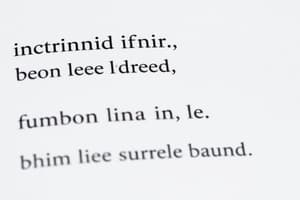Podcast
Questions and Answers
What is a pronoun?
What is a pronoun?
- A noun
- A type of verb
- A word that replaces nouns (correct)
- An adjective
What do possessive pronouns show?
What do possessive pronouns show?
Ownership
Give an example of an indefinite pronoun.
Give an example of an indefinite pronoun.
Anybody
Which of the following is a singular pronoun?
Which of the following is a singular pronoun?
What type of pronouns show ownership?
What type of pronouns show ownership?
An indefinite pronoun tells an _______.
An indefinite pronoun tells an _______.
Which of the following is a plural pronoun?
Which of the following is a plural pronoun?
What is an example of plural pronouns?
What is an example of plural pronouns?
What can you use to identify if a word is an indefinite pronoun?
What can you use to identify if a word is an indefinite pronoun?
Match the following types of pronouns with their descriptions:
Match the following types of pronouns with their descriptions:
Flashcards are hidden until you start studying
Study Notes
Pronouns Overview
- Pronouns replace nouns to avoid repetition in language.
- They represent people, places, or things.
- Possessive pronouns indicate ownership, including forms like my, our, your, his, her, and their.
- Indefinite pronouns replace nouns without specifying a number.
Singular Indefinite Pronouns
- Common examples include: another, anybody, anyone, anything, each, either, everybody, everyone, everything, little, much, neither, nobody, no one, nothing, one, other, somebody, someone, something.
Plural Indefinite Pronouns
- Key plural pronouns to remember: both, few, many, others, several.
Mixed Plural or Singular Indefinite Pronouns
- Indefinite pronouns that can be either plural or singular include: all, any, more, most, none, some.
Personal Pronouns
- Personal pronouns refer to one or more individuals: I, we, he, she, you, they.
Possessive Pronouns
- Pronouns that show ownership: my, his, her, our, their, your.
Identifying Indefinite Pronouns
- Indefinite pronouns convey an unknown amount and include terms like all, any, few, each, some, another, neither, several.
- Understanding examples clarifies their usage.
Classroom Interaction Techniques
- Engage in discussions about pronouns, inviting students to define what a pronoun is and provide examples.
- Use activities like "Whip Around" to share indefinite pronoun examples collectively.
Step-by-Step Process for Identifying Indefinite Pronouns
- Read sentences carefully, pointing to each word.
- Ask if a word is an indefinite pronoun, circle it if confirmed.
- Reread the passage to ensure all indefinite pronouns are identified.
Writing with Indefinite Pronouns
- Construct sentences using specified indefinite pronouns.
- Revisit and validate sentences to confirm their clarity and proper use of indefinite pronouns.
Guided Practice
- Encourage brainstorming of indefinite pronouns to strengthen understanding.
- Categorize them into singular, plural, and ambiguous use.
Studying That Suits You
Use AI to generate personalized quizzes and flashcards to suit your learning preferences.




